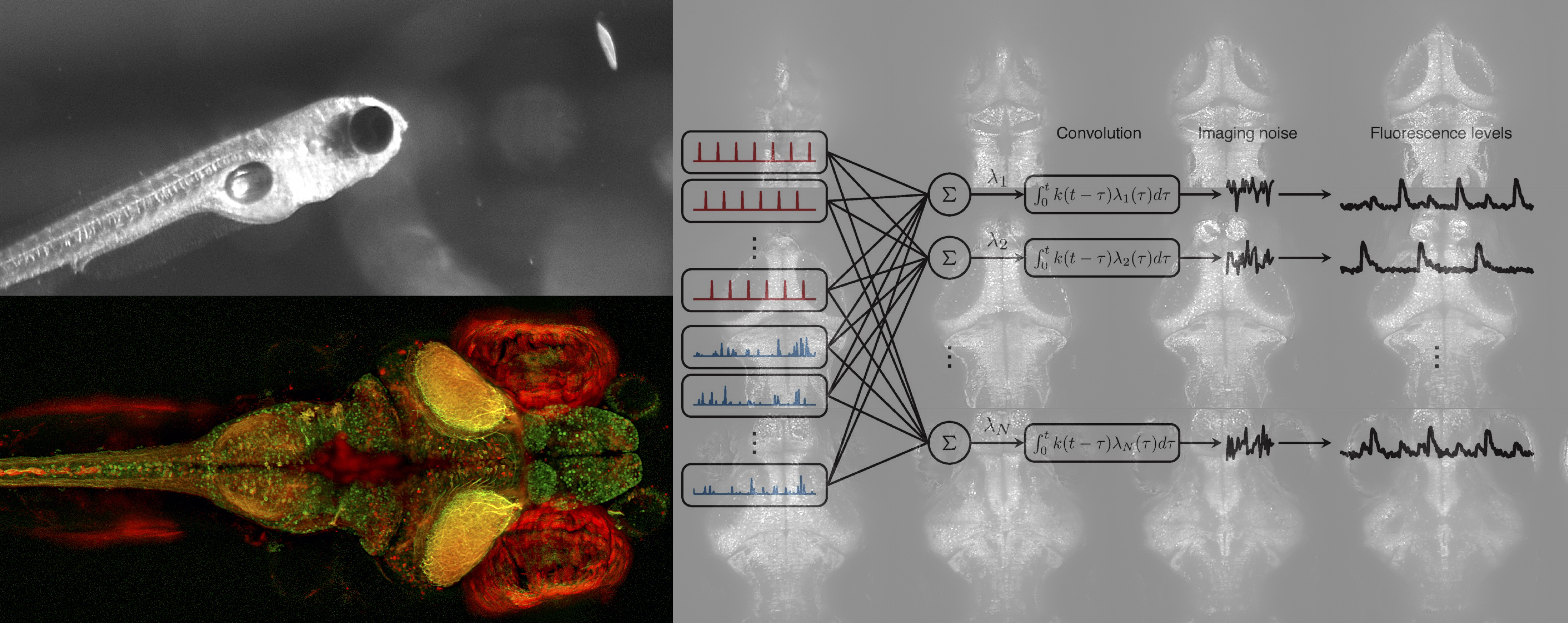Neural coding in the
zebrafish brain
What is the `neural
code' by which patterns of electrical
activity in the brain represent
information, how does this subserve
behavior, and how do neural coding and behavior develop? We are
investigating these questions using the
zebrafish model system. Zebrafish larvae
show sophisticated hunting behaviours from an
early age. Furthermore they are transparent,
so that we can use genetically-encoded
calcium indicators to optically record the activity of
many neurons simultaneously. By making experimental
measurements of neural activity and hunting
behaviour, and analysing these with a variety of
sophisticated mathematical approaches, allows us
to investigate how neural coding and complex
behaviours develop in tandem during early life.
-
Spontaneous and evoked activity patterns diverge over
development.
In this paper in
eLife we recorded spontaneous and evoked neural activity in
the larval zebrafish tectum from 4 to 15
days post-fertilisation and found that,
according to several metrics, spontaneous
and evoked activitydiverged over
development. This is different from the
case in some other systems, and suggests
that spontaneous activity in the
developing tectum may not acting as a
Bayesian prior for evoked activity.
-
Behavioral signatures of a developing neural code. How do
neural codes critical for behavior emerge
during development? In this paper in
Current Biology we showed that during early life
visually-driven hunting in larval
zebrafish improves, and this is
accompanied by increasing mutual
information and improved decoding of
visual stimuli in the optic
tectum. Moreover, decoding can predict
individual differences in hunting. See
also this review paper in Trends in Neurosciences.
-
The development of spontaneous activity in the
zebrafish brain. The optic tectum in the brain of the larval
zebrafish is highly active even without visual input. In this paper in
Current Biology we looked at this activity every day from 4-9
dpf (days post-fertilization) to examine how this activity
develops. Using tools from graph theory we showed how the
functional connectivity of the tectum changes over this time. By
manipulations like raising fish in the dark we also showed that
these changes were dependent on visual input during development. See
also this review paper.
-
Limitations of neural map topography for decoding spatial
information. A very common feature of brain wiring is that
neighboring points on a sensory surface (eg, the retina) are
connected to neighboring points in the brain. It is often assumed
that this “topography” of wiring is essential for decoding sensory
stimuli. However, in this paper in the
Journal of Neuroscience we showed in the developing zebrafish
that topographic decoding performs very poorly compared with methods
that do not rely on topography. This suggests that, although wiring
topography could provide a starting point for decoding at a very
early stage in development, it may be replaced by more accurate
methods as the animal gains experience of the world.
